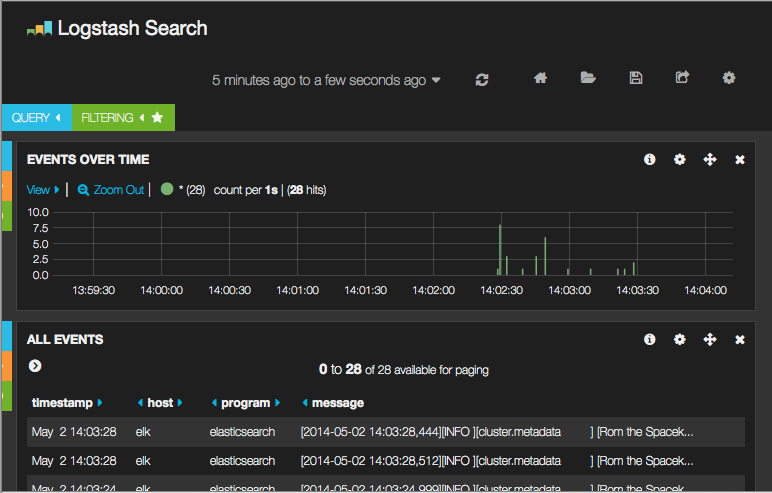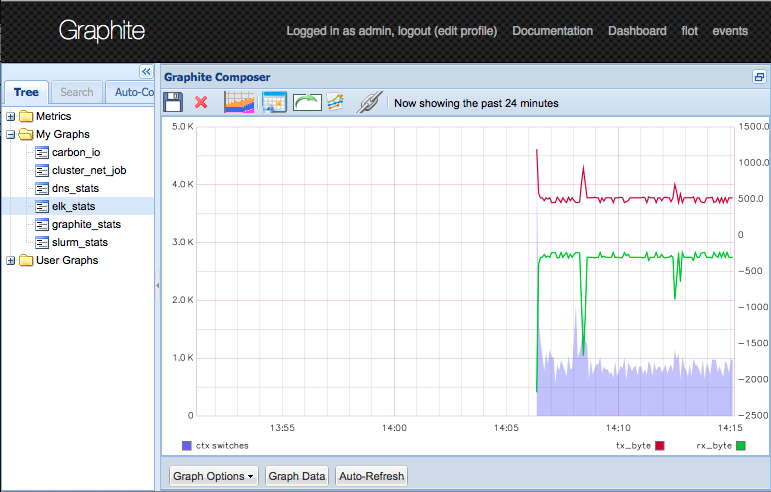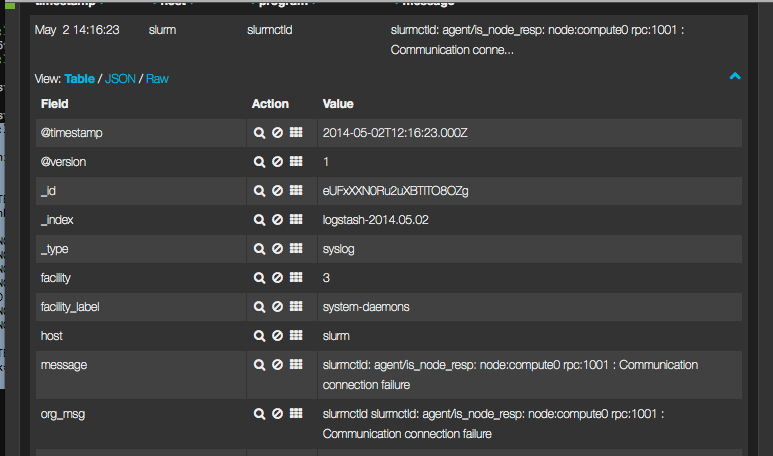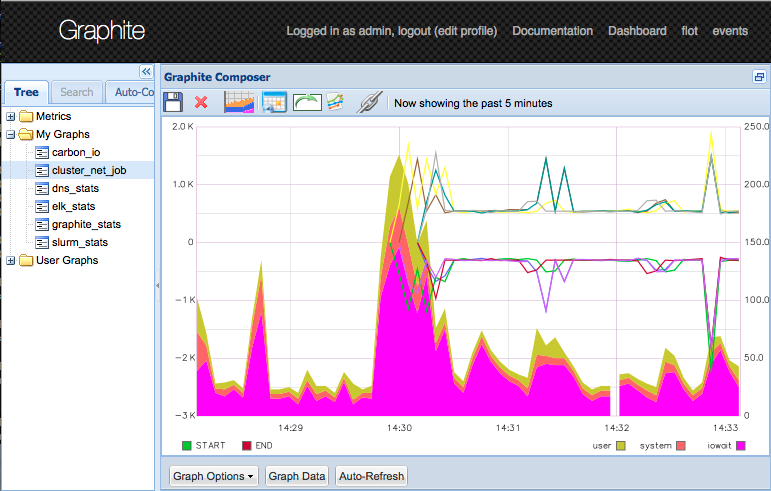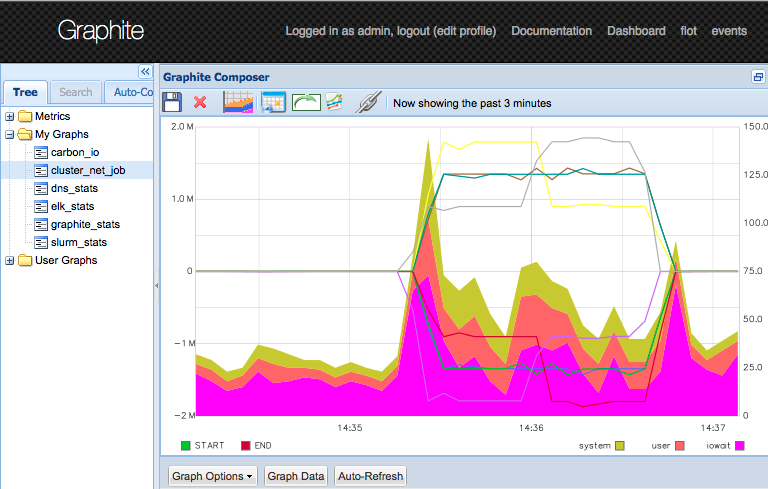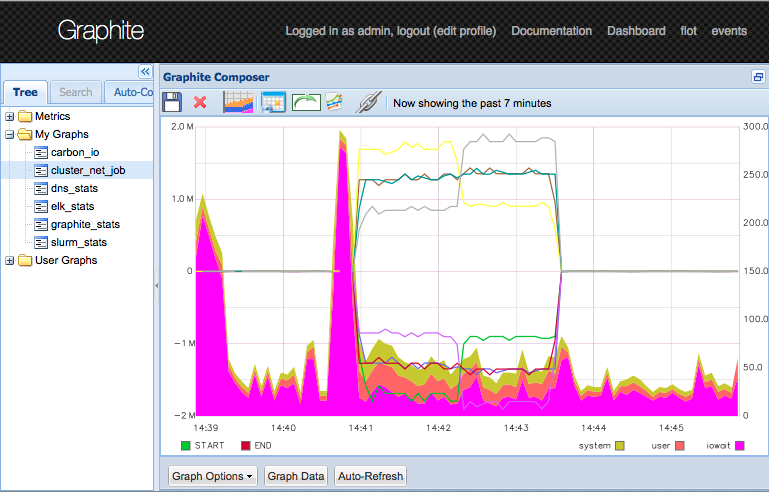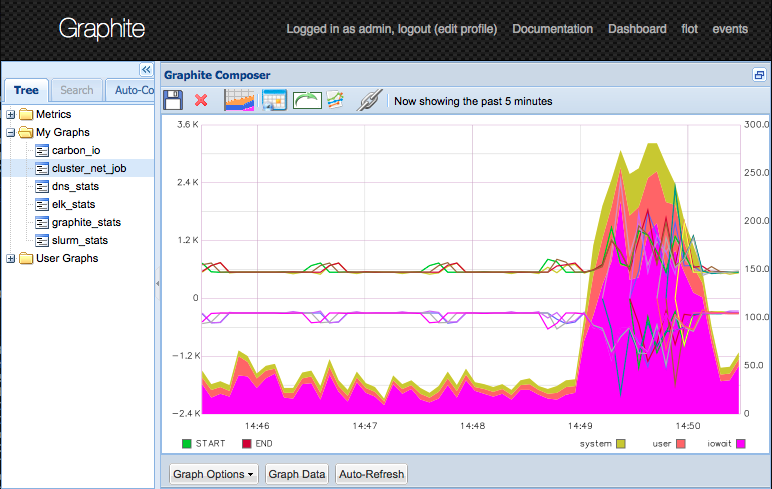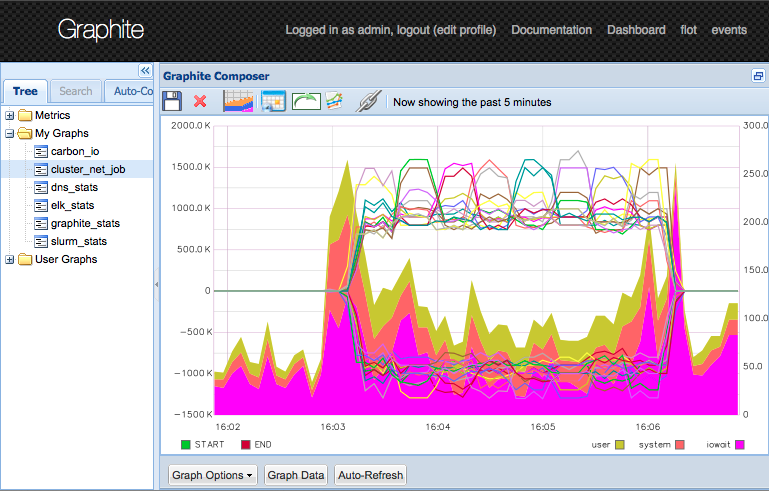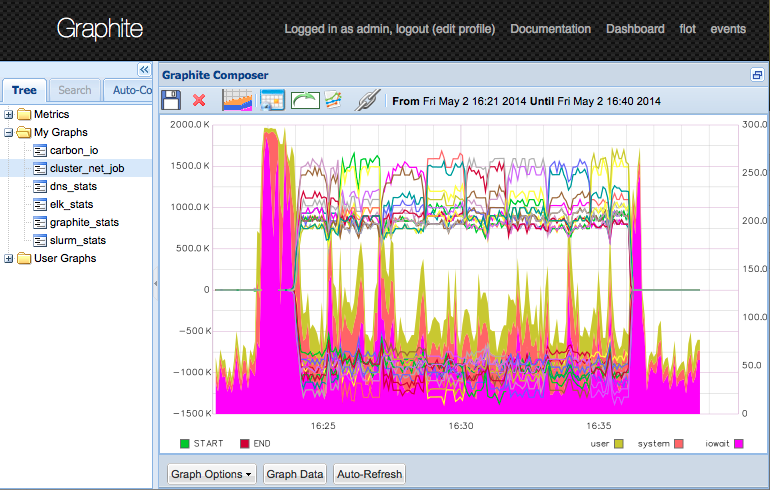Setup a basic QNIBTerminal
In my previous post I described what drove me to give docker a spin and create a virtual HPC cluster stack.
This post provides a step by step guide to run a basic QNIBTerminal with four nodes. To get this one going there is no need for a lot of horsepower. I ran it on a 3-core AMD machine from back in the days. Even a VM should be able to lift it.
Recap Docker
Unlike all the 'heavy' virtualization techniques out there, running a dedicated kernel in an (more or less) emulated a x86 environment, Docker (like BSD jails, Solaris zone, OpenVZ) is kind of 'chroot on steroids'.
The process spawned within a container uses the same kernel then the host system; but [sic!] it is encapsulated in terms of processes (PID namespace), mount points (mount namespace), network (net namepsace), interprocess communication (ICS namespace). As if this alone wouldn't be awesome enough containers can be strangled by cgroups.
Anyway, one might forget the last two paragraphs and just pretend it is a strangely fast VM.
Bootstrap Docker
Personally I use RedHat derivates, currently fedora20, since it should be close to RHEL7, which will be the Linux derivate of choice within HPC (at least the HPC environment I work in, sorry SUSE).
Installing docker is quite simple
If installed on a remote machine it comes in handy to expose a tcp-socket to everyone (or localhost and use a ssh-tunnel, don't try this in production). Furthermore I make sure that docker don't automatically restarts images and I like to put the docker directory onto a SSD to have better IO performance. With '-e lxc' docker uses the LXC backend in favor of the 'libcontainer' (directly talking to the kernel) backend, which allows the use of cgroups.
$ vim /usr/lib/systemd/system/docker.service
## edit ExecStart to
ExecStart=/usr/bin/docker -d --restart=false -H tcp://0.0.0.0:6000 -e lxc -g /speed/docker
$ systemctl daemon-reload
$ systemctl start docker.service
And thats about it... Now one should be able to use docker.
# localhost might differ if your host is not... localhost
$ eport DOCKER_HOST=tcp://localhost:6000
$ docker ps -a
CONTAINER ID IMAGE COMMAND CREATED STATUS PORTS NAMES
$ docker images
REPOSITORY TAG IMAGE ID CREATED VIRTUAL SIZE
Start QNIBTerminal
After cloning the github repository the bashrc provides useful function to spawn the cluster. First pulling all the images needed for QNIBTerminal. Depending on your internet connection you might give a dime; but my wopping 1.5MB/s is a reason to preload and do something else in the meantime.
$ git clone git@github.com:ChristianKniep/QNIBTerminal.git
Cloning into 'QNIBTerminal'...
remote: Counting objects: 10, done.
remote: Compressing objects: 100% (8/8), done.
remote: Total 10 (delta 3), reused 6 (delta 2)
Receiving objects: 100% (10/10), done.
Resolving deltas: 100% (3/3), done.
Checking connectivity... done.
$ cd QNIBTerminal
$ source bashrc
$ d_pullall
Sun Apr 27 19:18:10 CEST 2014
*snip*
b69335c437a4: Download complete
Sun Apr 27 19:45:31 CEST 2014
OK, now we are talking...
14 13:56:02 rc=0 DOCKER:localhost QNIBTerminal $ docker images|grep qnib
qnib/slurm latest 3cf7f9614746 15 hours ago 1.187 GB
qnib/helixdns latest bf63f948f8b9 16 hours ago 807.8 MB
qnib/etcd latest 3ea82ae02faa 19 hours ago 645.6 MB
qnib/supervisor latest 1da5684a6f79 19 hours ago 613.1 MB
qnib/fd20 latest 803582e382a8 20 hours ago 585.4 MB
qnib/graphite latest 7f936a42e88d 2 days ago 1.23 GB
qnib/elk latest 97e2c22e8b0f 2 days ago 1.185 GB
Containerize all the things
qnib/helixdns
The basic building block of QNIBTerminal is the dns image, which also might serve as inventory in the future. '1' as an argument attaches a bash to the container. Once spawned we start supervisord in detached mode.
15 13:56:10 rc=0 DOCKER:localhost QNIBTerminal $ start_dns 1
bash-4.2# su -
[root@dns ~]# ./bin/supervisor_daemonize.sh
[root@dns ~]# supervisorctl status
etcd RUNNING pid 35, uptime 0:00:26
helixdns RUNNING pid 34, uptime 0:00:26
setup EXITED May 02 01:58 PM
startup EXITED May 02 01:58 PM
[root@dns ~]#
Neat, the first part is already up and running.
qnib/elk
Next up: The log managment container.
7 14:02:05 kniepbert@AIIX3 rc=0 DOCKER:localhost ~ $ start_elk 1
bash-4.2# su -
[root@elk ~]# ./bin/supervisor_daemonize.sh
[root@elk ~]# supervisorctl status
diamond RUNNING pid 35, uptime 0:00:20
elasticsearch RUNNING pid 34, uptime 0:00:20
logstash RUNNING pid 39, uptime 0:00:20
nginx RUNNING pid 37, uptime 0:00:20
setup EXITED May 02 02:02 PM
syslog-ng RUNNING pid 36, uptime 0:00:20
[root@elk ~]#
And only with this two containers we are able to see stuff under port 81.
qnib/graphite
Now we start the graphite image to get some metrics. I do not intend to interact with this container much, so I start it detached.
1 14:06:03 kniepbert@AIIX3 rc=0 DOCKER:localhost ~ $ start_graphite
a1e288d677633d31e3e5383ac88ce068be3fd46f609f3f0d6bdca0cf80c78a76
2 14:06:15 kniepbert@AIIX3 rc=0 DOCKER:localhost ~ $ docker ps
CONTAINER ID IMAGE COMMAND CREATED STATUS PORTS NAMES
a1e288d67763 qnib/graphite /bin/sh -c /bin/supe 8 seconds ago Up 6 seconds *snip* graphite
c83c43026a4c qnib/elk /bin/bash 3 minutes ago Up 3 minutes *snip* elk
1bcda38c456e qnib/helixdns /bin/bash 8 minutes ago Up 7 minutes dns
3 14:06:21 kniepbert@AIIX3 rc=0 DOCKER:localhost ~ $
Graphite-web is now available under port 80 of the docker host (user/passwd: admin/admin).
docker host
To get metrics from the docker server we set up python-diamond and rename the host to 'docker' as to fit it into the predefined graphs within the qnib/graphite image.
If this is skipped, there are going to be no metrics present, so it's optional.
# cd
# git clone https://github.com/ChristianKniep/docker-terminal.git
# yum install -y docker-terminal/yum-cache/diamond/python-*
# yum install -y lm_sensors
# cp /etc/diamond/diamond.conf.example /etc/diamond/diamond.conf
# sed -i -e s'/^handlers =.*/handlers = diamond.handler.graphite.GraphiteHandler/' \
/etc/diamond/diamond.conf
# sed -i -e '/# hostname = `hostname`/a \hostname=docker' \
/etc/diamond/diamond.conf
# cat << \EOF > /etc/diamond/collectors/DiskUsageCollector.conf
enabled = True
path_suffix = ""
ttl_multiplier = 2
measure_collector_time = False
byte_unit = byte,
sector_size = 512
send_zero = False
devices = sd[a-z]+$
EOF
# echo "enabled = False" > /etc/diamond/collectors/MemoryCollector.conf
# echo "enabled = False" > /etc/diamond/collectors/HttpdCollector.conf
# cat << \EOF > /etc/diamond/collectors/NetworkCollector.conf
> enabled = True
> path_suffix = ""
> ttl_multiplier = 2
> measure_collector_time = False
> byte_unit = bit, byte
> interfaces = eth, bond, em, p1p
> greedy = true
> EOF
# export GRAPHITE_IP=$(docker inspect -f '{{ .NetworkSettings.IPAddress }}' graphite)
# sed -i -e "s/host =.*/host = ${GRAPHITE_IP}/" /etc/diamond/handlers/GraphiteHandler.conf
# sed -i -e 's/# interval =.*/interval = 5/' /etc/diamond/diamond.conf
# mkdir -p /var/log/diamond
### check if it works
# diamond -f -l
### if it does, fire up the daemon
# diamond
Now the graphite metrics of the host flowing in and are shown in the predefined graphs.
qnib/slurm
3 14:06:21 kniepbert@AIIX3 rc=0 DOCKER:localhost ~ $ start_slurm 1
bash-4.2# su -
[root@slurm ~]# ./bin/supervisor_daemonize.sh; sleep 25
[root@slurm ~]# supervisorctl status
confd_update_slurm RUNNING pid 43, uptime 0:00:23
confd_watch_nodes RUNNING pid 39, uptime 0:00:23
diamond RUNNING pid 36, uptime 0:00:23
munge RUNNING pid 41, uptime 0:00:23
setup EXITED May 02 02:16 PM
slurmctld RUNNING pid 338, uptime 0:00:15
syslog-ng RUNNING pid 38, uptime 0:00:23
[root@slurm ~]# sinfo
PARTITION AVAIL TIMELIMIT NODES STATE NODELIST
docker* up infinite 1 unk* compute0
[root@slurm ~]#
And slurmctld is already complaining about something.
But that is alright. If no compute node is found, the start-script of slurmctld will create a dummy node 'compute0'. Since it is not available, it is not reachable.
qnib/compute
The compute nodes are spawned.
29 14:28:55 kniepbert@AIIX3 rc=0 DOCKER:localhost ~ $ for x in {0..3};do start_compute compute${x};done
30 14:30:44 kniepbert@AIIX3 rc=0 DOCKER:localhost ~ $ docker ps --since-id=54de5513e355
CONTAINER ID IMAGE COMMAND CREATED STATUS PORTS NAMES
8af57317a37a qnib/compute /bin/sh -c /bin/supe 45 seconds ago Up 42 seconds compute3
973e82c0d968 qnib/compute /bin/sh -c /bin/supe 50 seconds ago Up 46 seconds compute2
bc9871a5f5ac qnib/compute /bin/sh -c /bin/supe 56 seconds ago Up 52 seconds compute1
1510fdea0f11 qnib/compute /bin/sh -c /bin/supe 59 seconds ago Up 56 seconds compute0
31 14:30:49 kniepbert@AIIX3 rc=0 DOCKER:localhost ~ $
Back to the slurm node we should see the slurm configuration adapt dynamically.
[root@slurm ~]# su - cluser
[cluser@slurm ~]$ sinfo
PARTITION AVAIL TIMELIMIT NODES STATE NODELIST
docker* up infinite 4 idle compute[0-3]
[cluser@slurm ~]$
To test the cluster the command 'hostname' is send to all nodes using the interactive 'srun' command.
Matrix Multiplication
4 nodes
A more complex workload than 'hostname' is a application which was kindly provided by a co-worker of mine, Jean-Noel Quintin. The program multiplies two matrizes in a smart way by split the work up (read: I do not know the details).
In the real-world (on bare metal), the programm saturates the resources of the host to be as fast as possible. Since QNIBTerminal overprovisions the host heavily, I introduced a line of sleep as to slow down the computation.
[cluser@slurm ~]$ sbatch -N4 /usr/local/bin/gemm.sh
Submitted batch job 3
[cluser@slurm ~]$ squeue
JOBID PARTITION NAME USER ST TIME NODES NODELIST(REASON)
3 docker gemm.sh cluser R 0:09 4 compute[0-3]
[cluser@slurm ~]$
This results in a fairly small job. The matrix size is not big.
A bigger job consumes more memory, and the nodes are by default limited to 125MB.
[cluser@slurm ~]$ sbatch -N4 /usr/local/bin/gemm.sh 32768
Submitted batch job 4
[cluser@slurm ~]$ squeue
JOBID PARTITION NAME USER ST TIME NODES NODELIST(REASON)
4 docker gemm.sh cluser R 0:07 4 compute[0-3]
[cluser@slurm ~]$
By increasing the size of the matrix the job grows. But be aware of your memory limit.
40 14:43:38 kniepbert@AIIX3 rc=0 DOCKER:localhost ~ $ top -b -n1 |egrep "(PID|gemm)"
PID USER PR NI VIRT RES SHR S %CPU %MEM TIME+ COMMAND
15302 cluser 20 0 283076 87296 796 S 12.4 2.2 0:10.53 gemm_block_mpi_
15301 cluser 20 0 283076 99344 788 S 6.2 2.5 0:07.28 gemm_block_mpi_
15304 cluser 20 0 283076 90096 840 S 6.2 2.2 0:05.69 gemm_block_mpi_
15303 cluser 20 0 283076 62580 816 S 0.0 1.5 0:07.18 gemm_block_mpi_
RES is shown in KiB which is close to 100MB.
16 nodes
12 more nodes would allow the job to run on 16 nodes (it should be a power of two).
41 14:43:55 kniepbert@AIIX3 rc=0 DOCKER:localhost ~ $ for x in {4..15};do start_compute compute${x};done
The nodes are creating some load and more lines in the network graph.
3 Core
To bad, the function assigns cpuid 2 to compute{0..9} and cpuid 3 to compute{10..19}.
Since I am working on a 3 core AMD, my machine only got up to coreid 2.
49 14:57:06 kniepbert@AIIX3 rc=0 DOCKER:localhost ~ $ docker logs compute10
lxc-start: Invalid argument - write /sys/fs/cgroup/cpuset/lxc/*snip*/cpuset.cpus : Invalid argument
lxc-start: Error setting cpuset.cpus to 3 for lxc/*snip*
Therefore I assign the cpuid for the upper compute nodes by myself.
58 15:01:50 kniepbert@AIIX3 rc=0 DOCKER:localhost ~ $ for x in {10..15};do start_compute compute${x} 0 2;done
# compute${x} => name
# 0 => detached
# 2 => cpuid
And here we go...
[cluser@slurm ~]$ sinfo
PARTITION AVAIL TIMELIMIT NODES STATE NODELIST
docker* up infinite 16 idle compute[0-15]
[cluser@slurm ~]$
16 node jobs
Now we submit a small job.
[cluser@slurm ~]$ sbatch -N16 /usr/local/bin/gemm.sh 32768
Submitted batch job 6
[cluser@slurm ~]$ squeue
JOBID PARTITION NAME USER ST TIME NODES NODELIST(REASON)
6 docker gemm.sh cluser R 1:25 16 compute[0-15]
[cluser@slurm ~]$
This job only consumes 40MB per node.
62 16:05:04 kniepbert@AIIX3 rc=0 DOCKER:localhost ~ $ top -b -n1 |egrep "(PID|gemm)"
PID USER PR NI VIRT RES SHR S %CPU %MEM TIME+ COMMAND
16315 cluser 20 0 183684 41716 4764 S 9.9 1.0 0:03.29 gemm_block_mpi_
16311 cluser 20 0 183844 41716 4764 S 5.0 1.0 0:04.34 gemm_block_mpi_
*snip*
Doubling the size of the input deck...
[cluser@slurm ~]$ sbatch -N16 /usr/local/bin/gemm.sh 65536
Submitted batch job 7
[cluser@slurm ~]$ squeue
JOBID PARTITION NAME USER ST TIME NODES NODELIST(REASON)
7 docker gemm.sh cluser R 0:21 16 compute[0-15]
[cluser@slurm ~]$
... close to doubles the memory usage.
71 16:08:20 kniepbert@AIIX3 rc=0 DOCKER:localhost ~ $ top -b -n1 |egrep "(PID|gemm)"
PID USER PR NI VIRT RES SHR S %CPU %MEM TIME+ COMMAND
20780 cluser 20 0 216452 73276 3568 S 0.0 1.8 0:01.76 gemm_block_mpi_
20781 cluser 20 0 216260 72772 3216 S 0.0 1.8 0:02.01 gemm_block_mpi_
Another doubeling...
[cluser@slurm ~]$ sbatch -N16 /usr/local/bin/gemm.sh 131072
Submitted batch job 8
[cluser@slurm ~]$ squeue
JOBID PARTITION NAME USER ST TIME NODES NODELIST(REASON)
8 docker gemm.sh cluser R 0:52 16 compute[0-15]
... gets me close to the cliff.
92 16:23:31 kniepbert@AIIX3 rc=0 DOCKER:localhost ~ $ top -b -n1 |egrep "(PID|gemm)"
PID USER PR NI VIRT RES SHR S %CPU %MEM TIME+ COMMAND
31932 cluser 20 0 281796 83096 396 S 0.0 2.1 0:02.51 gemm_block_mpi_
31933 cluser 20 0 281796 88716 832 S 0.0 2.2 0:02.71 gemm_block_mpi_
31934 cluser 20 0 281988 76132 888 S 0.0 1.9 0:02.42 gemm_block_mpi_
31935 cluser 20 0 281796 85628 864 S 0.0 2.1 0:03.01 gemm_block_mpi_
31936 cluser 20 0 281796 83940 820 S 0.0 2.1 0:02.73 gemm_block_mpi_
31937 cluser 20 0 281796 68608 844 S 0.0 1.7 0:02.65 gemm_block_mpi_
31938 cluser 20 0 281796 68468 856 S 0.0 1.7 0:02.54 gemm_block_mpi_
31939 cluser 20 0 281796 91644 880 S 0.0 2.3 0:02.48 gemm_block_mpi_
31940 cluser 20 0 281796 72520 864 S 0.0 1.8 0:01.84 gemm_block_mpi_
31941 cluser 20 0 281988 101244 412 S 0.0 2.5 0:02.62 gemm_block_mpi_
The host starts swapping... :(
So, that is basically it. A 4GB 3 core AMD node houses a 16node MPI cluster with 4 service nodes.
95 16:27:15 kniepbert@AIIX3 rc=0 DOCKER:localhost ~ $ docker ps
CONTAINER ID IMAGE PORTS NAMES
0a5d06847143 qnib/compute compute15
dc72d54800f7 qnib/compute compute14
91746138e462 qnib/compute compute13
84d6ab2a9b85 qnib/compute compute12
d1eb37b776fe qnib/compute compute11
4495302dff22 qnib/compute compute10
7922f80b53b2 qnib/compute compute9
d1eccf71cabf qnib/compute compute8
677548c1ea95 qnib/compute compute7
8ce797d795e6 qnib/compute compute6
cb2774c75667 qnib/compute compute5
1dc52f423f9e qnib/compute compute4
8af57317a37a qnib/compute compute3
973e82c0d968 qnib/compute compute2
bc9871a5f5ac qnib/compute compute1
1510fdea0f11 qnib/compute compute0
54de5513e355 qnib/slurm slurm
a1e288d67763 qnib/graphite 0.0.0.0:80->80/tcp graphite
c83c43026a4c qnib/elk 0.0.0.0:81->80/tcp, 0.0.0.0:9200->9200/tcp elk
1bcda38c456e qnib/helixdns dns

